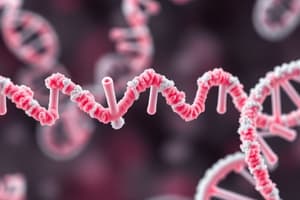Podcast
Questions and Answers
What is the main function of tRNA during cell division and transformation?
What is the main function of tRNA during cell division and transformation?
- Synthesizing proteins
- Transporting daughter cells
- Reading of mRNA by ribosomes (correct)
- Splicing in eukaryotes
How long are transfer RNA (tRNA) molecules on average?
How long are transfer RNA (tRNA) molecules on average?
- 50-60 bases
- 73-93 bases (correct)
- 100-120 bases
- 10-20 bases
Where is small nuclear RNA (snRNA) primarily located after transcription?
Where is small nuclear RNA (snRNA) primarily located after transcription?
- Endoplasmic reticulum
- Mitochondria
- Cytoplasm
- Nucleus (correct)
Which RNA polymerase is responsible for the synthesis of mRNA?
Which RNA polymerase is responsible for the synthesis of mRNA?
Where does transcription primarily take place in prokaryotes?
Where does transcription primarily take place in prokaryotes?
What determines the termination of RNA synthesis in prokaryotes?
What determines the termination of RNA synthesis in prokaryotes?
What is the direction in which DNA polymerase reads the template strand during DNA replication?
What is the direction in which DNA polymerase reads the template strand during DNA replication?
What is the key to maintaining the sequence of nucleotides in DNA through new generations?
What is the key to maintaining the sequence of nucleotides in DNA through new generations?
What is the purpose of the replication apparatus during cell division?
What is the purpose of the replication apparatus during cell division?
What is the relationship between the two strands of the DNA double helix?
What is the relationship between the two strands of the DNA double helix?
What is the purpose of the hydrogen bonds formed between the two complementary strands of DNA?
What is the purpose of the hydrogen bonds formed between the two complementary strands of DNA?
Why is it important that the DNA sequence information be transferred faithfully during cell division?
Why is it important that the DNA sequence information be transferred faithfully during cell division?
Which of the following statements is correct about eukaryotic ribosomal RNA (rRNA)?
Which of the following statements is correct about eukaryotic ribosomal RNA (rRNA)?
What is the primary function of messenger RNA (mRNA) in both prokaryotes and eukaryotes?
What is the primary function of messenger RNA (mRNA) in both prokaryotes and eukaryotes?
Which of the following statements is true about prokaryotic mRNA?
Which of the following statements is true about prokaryotic mRNA?
What is the primary function of plasmids in prokaryotic cells?
What is the primary function of plasmids in prokaryotic cells?
Which of the following statements accurately describes large plasmids?
Which of the following statements accurately describes large plasmids?
What is the primary difference between large and small plasmids in prokaryotic cells?
What is the primary difference between large and small plasmids in prokaryotic cells?
What is the main function of DNA polymerase I (pol I)?
What is the main function of DNA polymerase I (pol I)?
What is the key difference between sexual and asexual recombination?
What is the key difference between sexual and asexual recombination?
What is the role of the F factor in bacterial conjugation?
What is the role of the F factor in bacterial conjugation?
What is the purpose of recombination in DNA?
What is the purpose of recombination in DNA?
What is the significance of the recombination process during meiosis?
What is the significance of the recombination process during meiosis?
What is the key difference between F+ and F- bacteria in the context of bacterial conjugation?
What is the key difference between F+ and F- bacteria in the context of bacterial conjugation?
What is the primary role of RNA polymerase during transcription?
What is the primary role of RNA polymerase during transcription?
Which of the following enzymes is responsible for cleaving double-stranded RNA?
Which of the following enzymes is responsible for cleaving double-stranded RNA?
What is the primary function of RNase P?
What is the primary function of RNase P?
Which of the following is a characteristic of RNA helicases?
Which of the following is a characteristic of RNA helicases?
What is the primary difference between endoribonucleases and exoribonucleases?
What is the primary difference between endoribonucleases and exoribonucleases?
Which of the following enzymes is responsible for digesting the RNA strand in a DNA-RNA hybrid?
Which of the following enzymes is responsible for digesting the RNA strand in a DNA-RNA hybrid?
Flashcards are hidden until you start studying




